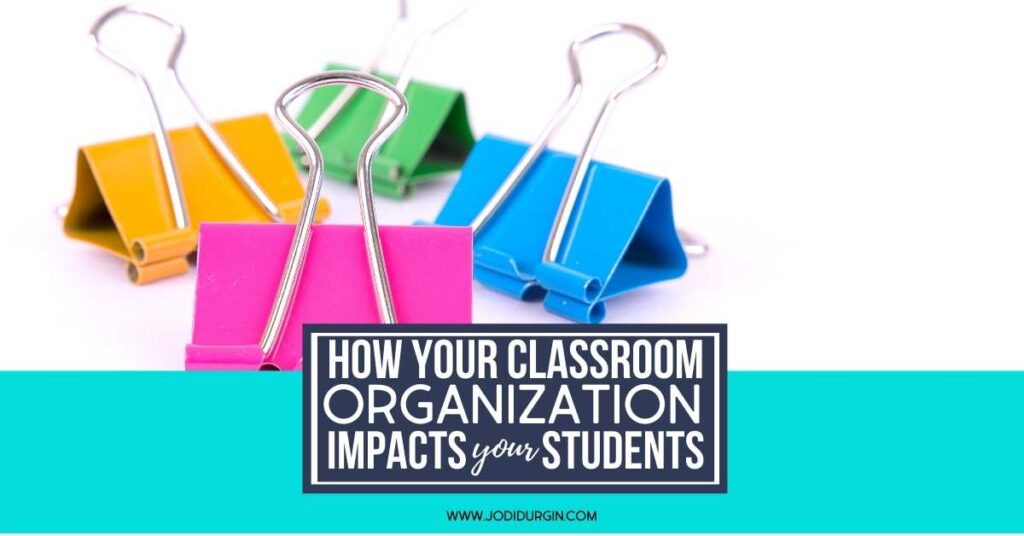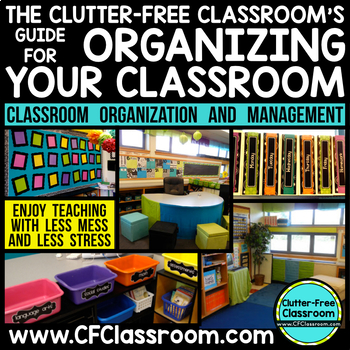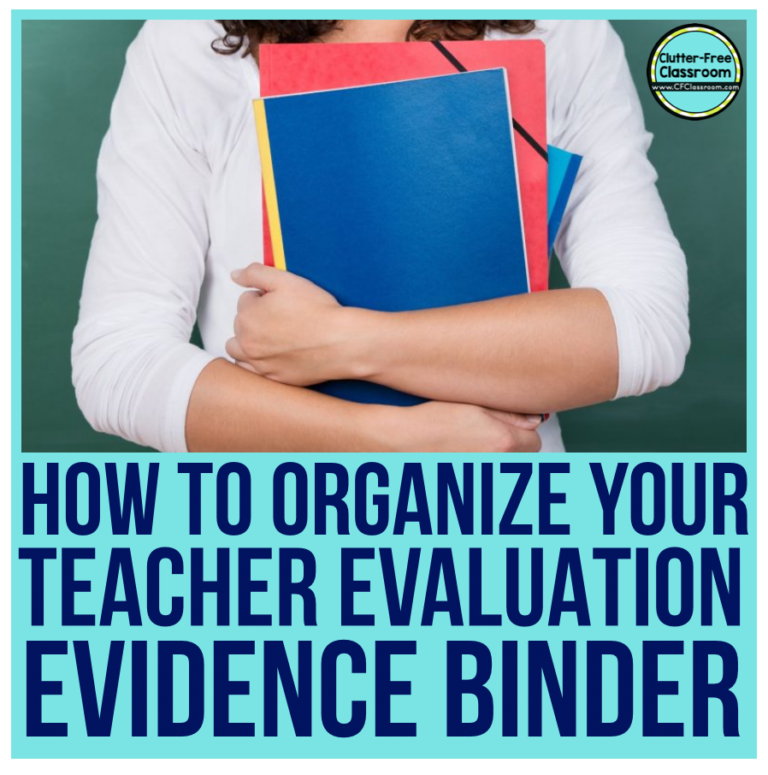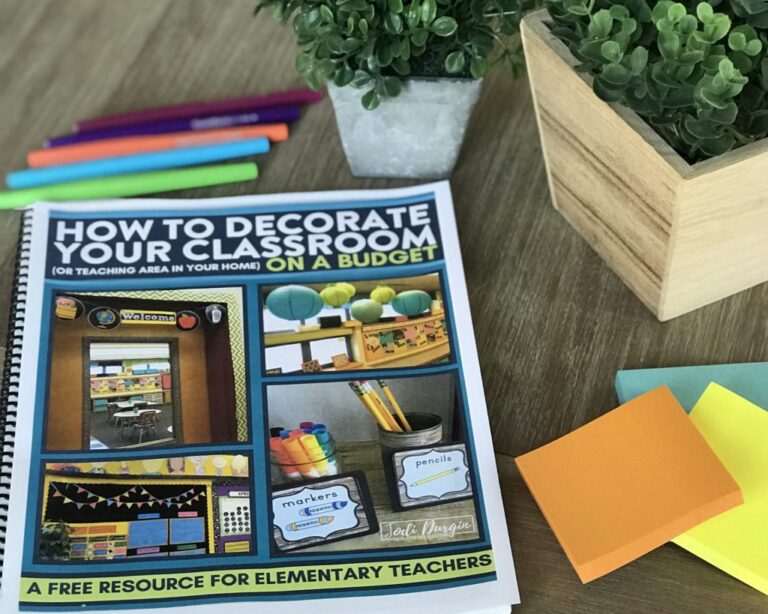Don’t you love the feeling of an organized space? I love knowing that each and every thing has a purpose and a specific place. It is the best feeling as a teacher! An organized classroom is not only beneficial for teachers, though. Your students benefit from this organization as well! It promotes a relaxed environment where they can focus and learn. Does your current classroom organization support your students? If not, read below to learn the importance of classroom organization and the impact it has on you and your elementary students.

7 Benefits of Being an Organized Teacher
You likely understand that having an organized classroom makes teaching easier and more enjoyable. However, you may not realize all of the areas having an organized classroom impacts. Read the 7 benefits of being an organized teacher listed below that demonstrate the importance of classroom organization.
1. Saves you time
Are you often late for school because you are running around your home packing up your school bag, looking for the papers you’ve scattered over the weekend or trying to locate your car keys? Do you end up staying at school later than you would like because tasks require looking for supplies and materials? This doesn’t have to be the case. Getting organized is the key to getting back valuable lost time!
2. Saves you money
How many times have you bought a book or a teaching tool and then soon discovered you had the same item hidden in a closet? How many things have you replaced because improper storage left them crushed, bent, folded or faded? An organized classroom will spare you those expenses. You spend enough on your classroom already!
3. Improves your professional relationships
The third benefit of being an organized teacher that demonstrated the importance of classroom organization is the impact it has on your professional relationships. Whether you realize it or not, clutter can affect your interpersonal relationships with the important people you work with daily. Parents and colleagues rely on you to be on time and to quickly fulfill your professional responsibilities without running late, missing deadlines, or failing to fulfill your promises. Being on top of everything frees up your time. You can use this time to enjoy lunch in the teacher’s lounge, visit with other teachers, and be part of any Friday festivities that may be planned for after school.
4. Improves your health
Teaching is stressful enough. A disorganized classroom adds additional stress to your busy life. Stress wreaks havoc on your body and your mind. Additionally, clutter enables dust and allergens to collect which can trigger allergies, cause headaches, sniffles, and sore throats. Getting your classroom decluttered and organized will also free up extra time for you to go for walks, hit the gym, or enjoy relaxing hobbies.
5. Makes you happier
Disorganization can negatively affect your mood. It’s hard to enjoy teaching when you feel like you are always stressed and overwhelmed by a chaotic schedule and a clutter-filled environment. Being on top of all that you have to do, and transforming your classroom into an organized learning space, will have you feeling energized, productive, and proud to have parents, colleagues, and administrators visit.
6. Saves your personal space
Do you have bins and tubs containing classroom materials stored in your home? Are you driving around with school books and supplies in your car? Your home and your vehicle are your personal space. They shouldn’t be taken over by the mounds of classroom materials that belong at the school. Having this separation will help you unplug and not think about school during your nights and weekends.
7. Makes you a more effective teacher
Is lesson planning a chore because your books and resources aren’t easily accessible? Do your students get off task waiting for you to find something you forgot to have handy for your lesson? Finding your planning or lesson materials quickly will allow you more time to be creative in your lessons. In addition, it will provide you with those crucial extra minutes to spend helping your struggling learners.
The Impact of an Organized Classroom on Students with Learning Differences
Having an organized classroom is helpful for all students, but especially for students with learning differences. I cannot overstate the importance of classroom organization.
There are 13 categories of special education according to IDEA:
- Autism
- Blindness
- Deafness
- Emotional Disturbance
- Hearing Impairment
- Intellectual Disability
- Multiple Disabilities
- Orthopedic Impairment
- Other Health Impaired
- Specific Learning Disability
- Speech or Language Impairment
- Traumatic Brain Injury
- Visual Impairment
Students with one or more of these diagnoses face unique challenges in general education settings that require the support of modifications and accommodations outlined in their IEP.
These are not the only students who face challenges in the general education setting. There are other students who do not qualify for an IEP, but qualify for a 504 plan. These students have support through accommodations outlined in their 504 plan.
All students, ones with and without learning differences, benefit from an inclusive, kind, and welcoming learning environment that can be characterized by structure, consistent routines, and organization.
In particular, students with anxiety and ADHD benefit from this type of classroom tremendously. In this environment, they know what is expected of them and what is happening next within the school day.
An organized classroom benefits all students in your classroom. However, your students with learning differences benefit in a greater capacity. It provides them an environment that empowers them to reach their highest potential in the general education classroom.
How to Have an Organized Classroom
Now that you understand the importance of classroom organization, let’s get started!
Your first step in getting the organized classroom of your dreams is to declutter. That’s right – throw out the trash, recycle the unnecessary papers, and purge the things you don’t need anymore. Easier said than done, right?
If you want to take all of the guess work out of the decluttering process, check out this post about how to declutter your classroom and this free classroom decluttering challenge. They will have your room looking much more organized and have you feeling less overwhelmed in under an hour! Sign up for the challenge and make this year the year you feel less stressed, enjoy teaching in your clutter-free classroom, and stop taking school work home on your nights and weekends. Sign up now!
If you want to go beyond a 1 hour clean out, then check out The Clutter-Free Classroom Guide to Classroom Organization. It makes the whole process of organizing your classroom super easy to get the classroom you deserve with a systematic procedure that guides you step-by-step through the organization process. It has proven tips, systems, and ideas to make your job so much easier! This classroom organization guide is also available in my Classroom Organization workshop.







